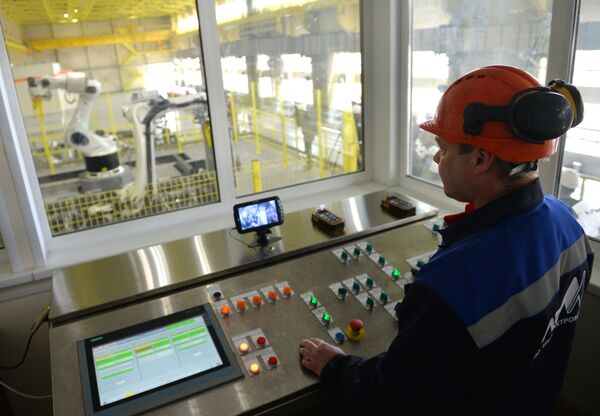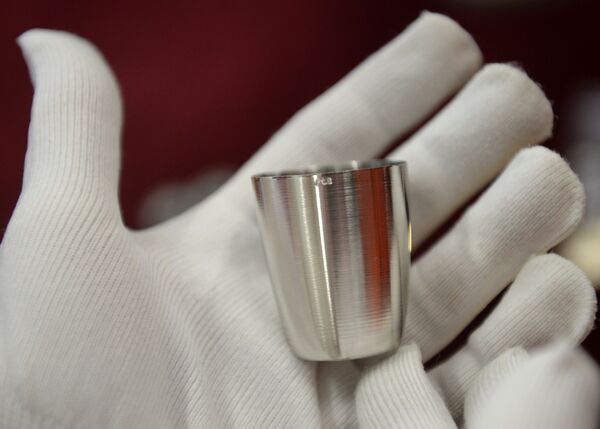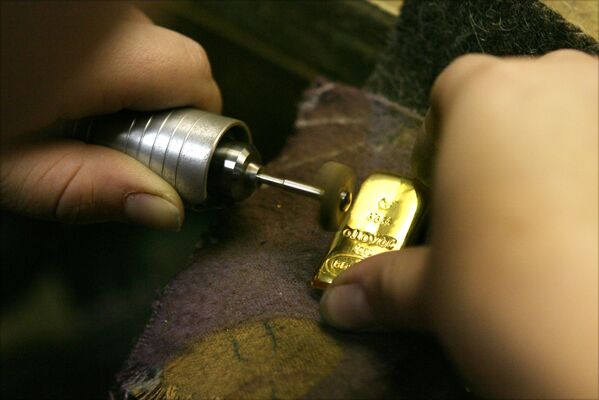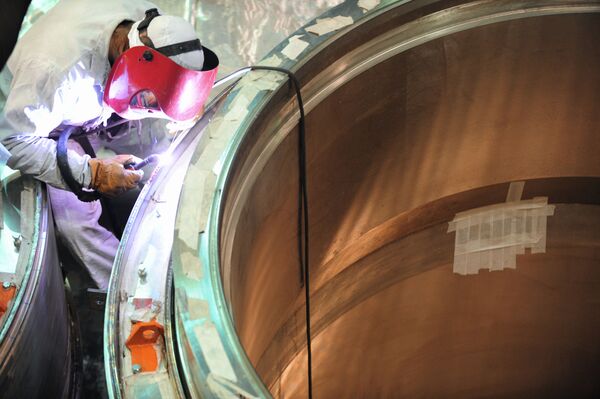University science laboratories are continuously working on new progressive solutions; the best of which receive state awards. In this photo report compiled by Rossiya Segodnya’s Social Navigator project together with the National University of Science and Technology MISiS (NUST MISiS to mark the 100th anniversary of the university), a few little-known facts about technologies that have influenced the development of various Russian industries are presented.

The development of modern infrastructures (both city and industrial) requires constantly increasing volumes of pipe rolling production. No construction can be complete without using steel pipes. In 1972, the rector (1965-1986) of the National University of Science and Technology MISIS (NUST MISiS) Pyotr Polukhin and professor at NUST MISiS Plastic Deformation of Special Alloys Department Ivan Potapov received a USSR State Award for a development that allowed the stability of the steel pipe screw rolling process to be increased, and lead to a boost in production volumes of hot-rolled pipes.
Above: modern-day pipe rolling.
Above: modern-day pipe rolling.

Polishing is an important stage in the production of electronics, optics and medical products. The use of rare-earth metals has made high-quality polishing possible. The serial production of these metals was launched by Alexander Yelyutin, graduate and, subsequently, the head of the NUST MISiS High-Temperature Materials Department. In 1976 this innovation received a USSR State Award.
Above: Rare-earth element Europium.
Above: Rare-earth element Europium.

The Romelt technology was developed in order to reduce environmental risks and make the production of cast iron cheaper. First implemented at the Novolipetsk Steel plant (NLMK Group), this technology permitted a reduction in the cost of cast iron production by 15 to 30 percent. In 1980, its inventor, head of the NUST MISiS’ College of Economics and Industrial Management Vladimir Romenets received a State Award.
Above: Russian Prime Minister Dmitry Medvedev, second to the right, during a visit to the Novolipetsk Steel plant (NLMK Group). On the right - NLMK Group CEO Oleg Bagrin, on the left - Chairman of NLMK Group's Board of Directors Vladimir Lisin. July 18, 2014.
Above: Russian Prime Minister Dmitry Medvedev, second to the right, during a visit to the Novolipetsk Steel plant (NLMK Group). On the right - NLMK Group CEO Oleg Bagrin, on the left - Chairman of NLMK Group's Board of Directors Vladimir Lisin. July 18, 2014.

The technology to preserve diamonds during blast-hole drilling on kimberlite pipes, a process that was developed by NUST MISiS graduate and General Director of Yakutalmaz Valery Rudakov, improved the quality of diamond extraction, while reducing the cost of recovery and ensuring the safety of mining projects. In 1982, this development received a USSR State Award.
Above: Then Russian Prime Minister Vladimir Putin examining the Mir diamond mine. On the right - Vyacheslav Shtyrov, President of the Republic of Sakha (Yakutia) (2002-2010). August 21, 2009.
Above: Then Russian Prime Minister Vladimir Putin examining the Mir diamond mine. On the right - Vyacheslav Shtyrov, President of the Republic of Sakha (Yakutia) (2002-2010). August 21, 2009.

In the late 1980s, the introduction of automated control systems (ACSs) reduced the costs of industrial production. After their introduction, the approximate cost of producing a ton of high-quality steel was 20 rubles ($12 according to the official 1989 exchange rate). In 1989, dean of IT and Economics Faculty and head of the NUST MISiS’ Automated Control Systems Department Anatoly Dyachko received a State Award for the development of ACSs.
Above: An automated section for cleaning and packing cathodes at the Uralelektromed plant in Verkhnyaya Pyshma.
Above: An automated section for cleaning and packing cathodes at the Uralelektromed plant in Verkhnyaya Pyshma.

6/10
© Photo : National University of Science and Technology MISiS/Sergey Gnuskov
Cobalt-based permanent magnets are used in control and guidance systems, nuclear test monitoring systems and electrical devices. The technology for producing magnets, which was developed by Alexei Lileyev, dean of the NUST MISiS Department of Physics and Chemistry, allowed for components to be reused and thus created cost savings on expensive and scarce materials. In 1999, Alexei Lileyev received a State Award for his work.
Above: A cobalt-based permanent magnet.
Above: A cobalt-based permanent magnet.

In the early 21st century, it became possible to obtain pure platinum, palladium and gold through direct extraction, and with higher recovery rates, from solutions of any composition. This new cost-effective method was developed by Alexander Yelyutin, deputy head of NUST MISiS’ High-Temperature Materials Department. In 2002, he received a State Award for this work.
Above: Laboratory equipment made from platinum.
Above: Laboratory equipment made from platinum.

The introduction of bacterial tank leaching ensured delay-free gold mining in the Far North. This in turn streamlined the process of separating gold from sulfide minerals (reducing the process to 80 to 120 hours from several months) and improved its manageability, as well as enabled the process to be conducted regardless of seasonal temperature changes. In 2007, professor at NUST MISiS’ Department for Enrichment of Non-Ferrous and Precious Metal Ores Eduard Adamov received an award for this development.
Above: Cleaning and polishing gold bars at Novosibirsk Refinery.
Above: Cleaning and polishing gold bars at Novosibirsk Refinery.

To ensure the stable operation of the country’s thermal power stations and plants, a special coal delivery system was established. The development of a new technology for the efficient grinding of frozen and oversized coal ensured a delay-free fueling process. In 2010, head of the Mining Machines and Equipment structural unit of NUST MISiS’ Mining Equipment, Transport and Machine Building Department Leonid Kantovich received a Russian Federation State Award.
Above: Unloading coal at Enel Russia’s Reftinskaya thermal power plant.
Above: Unloading coal at Enel Russia’s Reftinskaya thermal power plant.

The creation of a new class of steel allowed for operating lives of nuclear power plants to be extended up to 100 years. In 2012, its creator, head of NUST MISiS Department of Metal Protection and Surface Technology Alexei Dub received a State Award.
Above: a worker carrying out a welding job while assembling a reactor in the clean area of the BN-800 power unit at Beloyarsk Nuclear Power Plant.
Above: a worker carrying out a welding job while assembling a reactor in the clean area of the BN-800 power unit at Beloyarsk Nuclear Power Plant.

